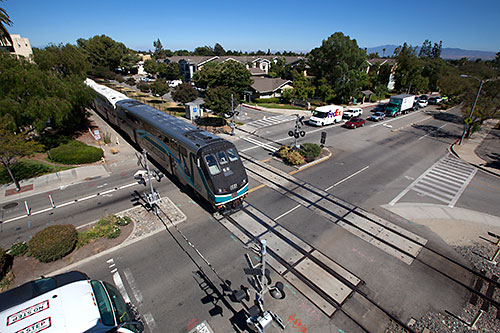New bridge may be unwanted consequence from Gold Line

Indian Hill Boulevard might get a bridge after all.
That information was revealed during last night’s Traffic and Transportation Commission meeting, when Assistant City Manager Colin Tudor indicated the California Public Utilities Commission (PUC) may not allow an at-grade crossing—or street level crossing—across Indian Hill Boulevard when the Gold Line is built.
Mr. Tudor cited a number of factors that would lead the PUC to reject the Claremont City Council’s direction to ditch the bridge—increased traffic, the number of Gold Line trains expected to cross through the city (about 200 a day, according to Mr. Tudor), the number of tracks in one place and the number of pedestrians.
According to a Metro grade-crossing study cited by the city, the Indian Hill crossing was ranked the third worst crossing out of the more than 100 at-grade crossings in Los Angeles County.
The Metro Gold Line Foothill Extension Construction Authority offered to build the bridge across Claremont’s main drag in early 2016 as a way to alleviate future traffic problems. The construction authority indicated they would cover the costs for the bridge, up to $28 million, if approved.
The plan elicited negative response from some residents, who disliked the design of the concrete bridge and lambasted it as a tangible dividing line between north and south Claremont. In addition, the plans were not reviewed by city commissions.
In July 2016, the council voted 4-1 against the bridge and directed the crossing to remain at street level, seven months before Metro’s deadline of February 2017. Councilmember Joe Lyons was the only dissenting vote, citing increased traffic concerns once the Gold Line is built in 2026.
The street-level crossing might not fly after all, Mr. Tudor noted. During subsequent diagnostic meetings between city staff, Gold Line staff and PUC staff earlier this year, the subject of the Indian Hill crossing came up. The PUC staff noted it was “highly likely” they would require a bridge to be built, Mr. Tudor said.
The decision may be out of Claremont’s hands, as the PUC ultimately has the final authority to decide what gets built, Mr. Tudor said.
“This is not a city project, we don’t have that authority,” Mr. Tudor said. “So if the PUC says that it has to be grade separated, then it has to be grade separated.”
No formal decision has been made yet, and won’t be until the Gold Line plans are submitted to the PUC for review later this year, Mr. Tudor said.
But in the meantime, the city will be offering up new plans for a possible bridge during community meetings in the summer and the fall. The city has enlisted an architect to prep some designs for a bridge that would be palatable for residents, while also remaining within the $28 million bubble.
Those designs will be on display at a community meeting on July 24 at 5:30 p.m. at the Hughes Center for community feedback, Mr. Tudor noted.
The Gold Line extension will officially break ground in October 2017 and is set for completion by late 2025-early 2026.
Other aspects of the project heard by the commission include Gold Line station plans; plans for a new Metrolink station, to be moved to the east side of College Avenue; the potential for transit-oriented development; the project work plan and efforts to revamp existing train crossings for the Gold Line’s anticipated arrival.
More on the meeting will be available in this week’s edition of the COURIER.
—Matthew Bramlett
news@claremont-courier.com










0 Comments